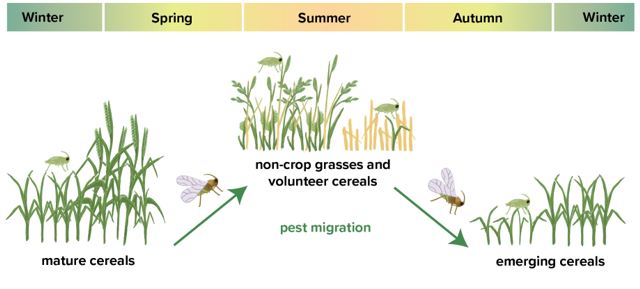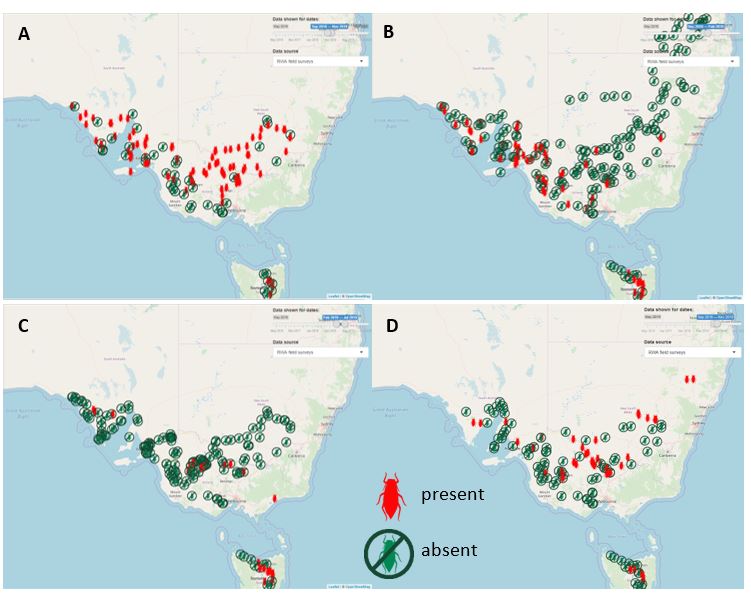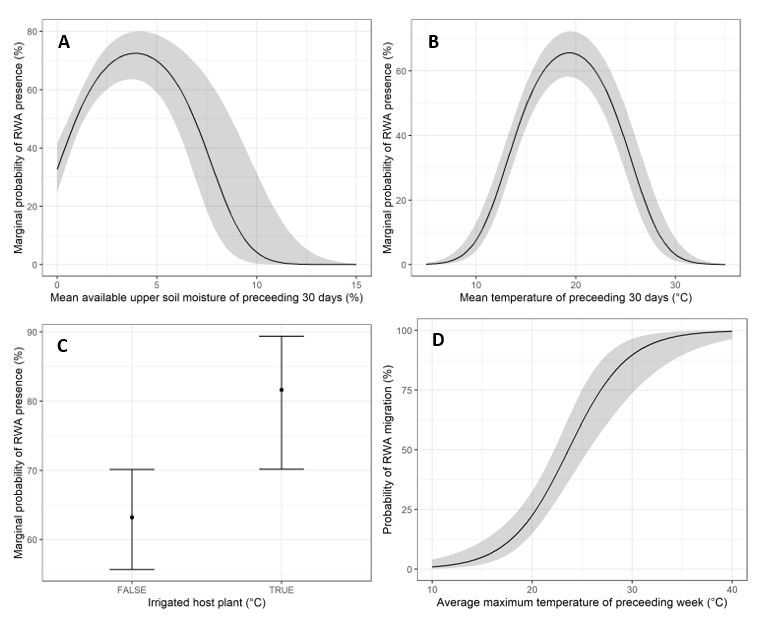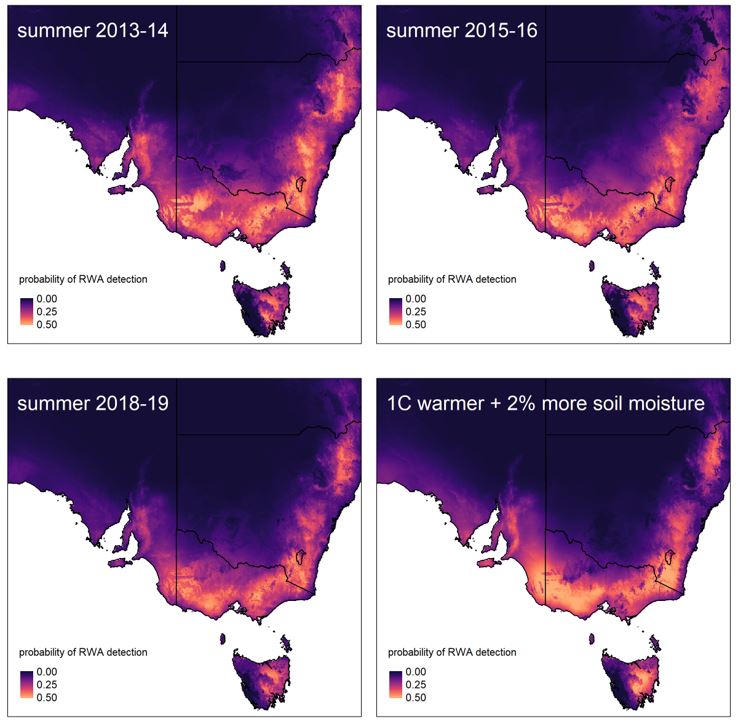How does climate affect the green bridge (and consequently aphid risk)?
How does climate affect the green bridge (and consequently aphid risk)?
Author: James Maino and Elia Pirtle (cesar), Maarten van Helden (PIRSA-SARDI and The University of Adelaide), Thomas Heddle (PIRSA-SARDI), and Paul Umina (cesar and The University of Melbourne). | Date: 08 Feb 2020
Take home messages
- Australia’s future climate will see new rainfall and temperature patterns, which will have complex effects on pest risk in grain crops.
- Increases in summer rainfall since the 1980s across grain growing regions may be increasing the summer availability of non-crop plants that form a ‘green bridge’ between winter crops for pests. This can enhance early aphid colonisation on establishing winter grains crops and pose more risks to yield loss compared with late season colonisation events.
- Russian wheat aphid persistence over the green bridge was found to be associated with moderate temperatures (<20°C), low-moderate available soil moisture (5% in 0-10cm), with migration occuring when daily maximum temperatures exceed 24°C.
- This knowledge was used to generate risk maps from climatic data to better understand the role of changing climates on pests and enhance foresight and precision in pest monitorring and management (Tips and Tactics: Russian Wheat Aphid)
Background
Australia’s changing climate will introduce new challenges to the grains industry including different patterns of pest risk. In south-eastern production regions, summer conditions are a crucial period for the persistence of many pests that must take refuge from hot and dry conditions in local patches of remaining green material to ‘bridge’ the host gap between winter crops (also known as the green bridge, Figure 1). When summer moisture is available and temperatures are mild, pest populations in summer refuges can quickly build up in numbers and readily colonise establishing crops or nearby weeds in the following autumn. Additionally, the risk of exposure to such conditions has increased due to growers sowing earlier. While Australia has observed a general decrease in winter rainfall across southern grain production regions since the 1980s, there has been a modest increasing trend in summer rainfall, which positively affects the availability of green material over summer and enhances the green bridge. On the other hand, higher temperatures will have a negative effect on the suitability of summer refuges for pests, which will reduce population numbers and invasion potential into crops the following season. These counter-opposing forces can have complex impacts on pest risk (Maino et al., 2016).
Figure 1. Schematic of the importance of available non-crops grass hosts and volunteer cereals over summer for pest populations to persist, build-up and colonise establishing crops in autumn.
Figure 2. Change in summer rainfall (A) and summer temperature (B) across Australia from 1980 to 2018 showing a trend towards wetter and warmer summers which will have consequences on green bridge mangement.
Russian wheat aphid (RWA), Diuraphis noxia, which feedson a variety of grasses (crop and non-crop)was first detected n Australia in 2016 (Yazdani et al., 2018), so is a recent addition to the pest aphids managed by Australian grain growers. A recent GRDC investment is aimed at generating knowledge on the behaviour and management of this pest under Australia’s unique climates and production systems. Examined in this paper is the role of the green bridge in pest populations of RWA, how populations depend on environmental conditions, such as temperature and soil moisture availability, particularly over the green bridge period, i.e. mid-spring through to mid-autumn, and how colonisation risk can change across years with diverse climates.
Methods
Surveys conducted in the grain growing regions of South Australia (SA), New South Wales (NSW), Victoria (Vic) and Tasmania (Tas) measured the occurrence of RWA across the green bridge at five time points from October 2018 to January 2020. RWA were suction sampled from host plants using a modified leaf blower, Berlese extraction of aphids from collected plant material and manual searching of grass heads. Half of the sites were randomly selected, while the remainder were targeted based on reports of RWA or the presence of grasses. Sampling took place across a diverse range of temperature and soil moisture conditions in order to relate aphid activity to differences in conditions between sample sites. This allowed the estimation of RWA presence based on site characteristics. The migration status of RWA populations was assessed using yellow pan traps at concurrently running field sites from sowing to harvest. Climatic patterns in RWA occurrence and migration status were then related to temperature and upper soil moisture data (0-10cm) from the Bureau of Meterology. Data were analysed using multiple logistic regression. For RWA occurrence (present = 1, absent = 0), a quadratic relationship of temperature and moisture was included (which performed better than linear relationships), as well as fixed effects for whether the site was targeted (versus randomly selected), or irrigated (versus not-irrigated). For RWA migration (winged-RWA present = 1, winged-RWA absent = 0), the average maximum temperature of the previous week was used based on previous knowledge of aphid migration cues.
Results and discussion
Russian wheat aphid populations on grasses and crops showed strong seasonal patterns of occurrence. They were detected widely across their distribution in the spring of 2018 (Figure 3A). As anticipated, this observed distribution contracted during the summer as temperatures increased and moisture availability decreased (Figure 3B). The observed distribution contracted further during a dry autumn in 2019 (Figure 1C) but had largely recovered their range (but not necessarily population sizes) again by the following spring despite continued dry conditions.
Figure 3. Presence and absence of RWA during spring 2018 (A), summer 2018/2019 (B), autumn 2019 (C) and spring 2019 (D). Interactive map of RWA occurrences measured across surveys available online (cesar - RWA Portal).
RWA presence was significantly affected by soil moisture (χ2 = 33.7, df = 2, p << 0.001) and temperature (χ2 =165.7, df = 2, p << 0.001), with intermediate values of each strongly associated with RWA presence (Figures 4A and 4B). Increasing soil moisture was positively associated with RWA presence as expected, but only up to about 5% available moisture, after which the effect of increasing soil moisture became negative. This could reflect the physical impact of high rainfall on aphids via the accumulation of fungal pathogens in very moist environments, or increased crop vigour during high moisture availability. Similarly, both low and high temperatures were negatively associated with RWA presence with an optimum temperature of around 20°C. This aligns with international research that showed maximum rates of RWA population growth occur around 20°C (Merrill, Holtzer and Peairs, 2009). As expected, irrigation (for example, for pastures) at survey sites was associated with increased RWA presence (χ2 =15.2, df = 1, p << 0.001) (Figure 4C). Using yellow pan trap data, the migration status of RWA exceeded 50% probability when the average maximum temperature of the preceeding week exceeded 24°C, with little to no migration occurring at 10°C and migration occurring with near certainty at 30°C (Figure 4D).
Figure 4. Holding all other variables at their mean observed values, the marginal effect on RWA occurrence of upper soil moisture (A), mean temperature (B), and irrigation status (C) of the survey site is shown for increasing values. The effect of average maximum temperature on RWA migration status is shown in subplot D. Confidence intervals are denoted by grey shading and error bars
Utilising these climatic relationships for pest occurrence, risk maps for RWA activity were constructed across the green bridge period using gridded climatic data. Such maps for the 2019 growing season are illustrated in Figure 5. In this period, the model predicts populations of RWA to be widespread across south-eastern grain growing regions in the spring of 2018 but retracting to more southern ranges by summer 2019. This highlights the importance of such regions; cooler and wetter regions close to the great dividing range as summer refuges where suitable grasses can be found. Grain growing regions near these locations may be at higher risk of an early season colonisation event. By autumn 2019, populations were predicted to be found at low levels across large areas of south-eastern grain growing regions, where early sown cereals, volunteer cereals, or grass weeds may form suitable targets for colonisation.
Figure 5. Predictions of suitable condition for RWA occurrence across the 2018/2019 green bridge period.
The developed predictive models were also used to explore pest risk across past and future conditions (Figure 6). The summer period for four scenarios was explored: 1) 2018/19 summer as the baseline for comparison; 2) 2015/16 summer for conditions preceding the first detection of RWA in Australia, 3) 2013/14 summer to explore conditions in a high outbreak year for other aphids, particularly green peach aphid (Myzus persicae), which resulted in widespread incidents of Turnip Yellows Virus and 4) a hypothetical climate change scenario where summer conditions are 1°C warmer with 2% more moisture avalability compared to 2018/19 conditions.
Compared with the summer of 2018/2019, summer conditions were much more favourable in 2013/14 and moderately more favourable in 2015/16. These conditions, particularly those in 2013/14, would have led to greater persistence of RWA over the summer warranting additional monitoring at crop establishment and utilisation of the Find, Identify, Threshold, Enact (FITE) strategy. Under the hypothetical climatic scenario with increased temperature and moisture availability, southern regions were predicted to play a stronger role in refugia hosting pests, while areas further inland become less suitable. In addition, greater areas of Tasmania’s cereal growing region were predicted to be more suitable for RWA.
Figure 6. Predictions of suitable condition for RWA occurrence across four scenarios: topleft - 2015/16 summer, which preceded the first detection of RWA in Australia, topright - 2013/14 summer, to explore conditions in a high outbreak year for aphids, particularly green peach aphid (Myzus persicae), which resulted in widespread incidents of Turnip Yellows Virus; bottom-left - 2018/19 summer as the baseline for comparison, and bottom-right - hypothetical climate change scenario where summer conditions are 1°C warmer with 2% more moisture avalability compared to 2018/19 conditions.
Conclusion
Climate was shown to have strong impacts on the occurrence of Russian wheat aphid across the green bridge and throughout the growing season suggesting that climatic conditions leading into the growing season should be considered when assessing aphid risk to establishing cereal crops. Spring conditions support the build up and widespread migration of aphids, which must then take refuge on available green material and suitable environmental conditions in order to persist to crop establishment in autumn.
Russian wheat aphid persistence over the green bridge was found to be associated with moderate temperatures (<20°C), low-moderate available soil moisture (5% in 0-10cm), with migration occuring when daily maximum temperatures exceed 24°C.
This knowledge was used to generate risk maps from climatic data to help to better understand the role of changing climates on pests. Enhanced understanding of the role of climate in the green bridge can be used in conjunction with the FITE strategy for RWA management. More generally, climate-informed models of pest risk will improve future precision in pest monitorring and management, particularly under more uncertain climateic conditions
Acknowledgements
The research undertaken as part of this project is made possible by the significant contributions of growers through both trial cooperation and the support of the GRDC, the authors would like to thank them for their continued support. We also thank Olivia Reynolds and Julia Severi for providing useful comments on an earlier draft.
Useful resources
Further information on RWA management is contained in the Russian Wheat Aphid: Tactics for Future Controlpublication, as well as I SPY, a comprehensive crop insect identification manual. A RWA resource portal hosted by cesar is available where additional information can be accessed, including distribution maps, project updates, and management advice.
References
Maino, J. L., Kong, J. D., Hoffmann, A. A., Barton, M. G., & Kearney, M. R. (2016). Mechanistic models for predicting insect responses to climate change. Current Opinion in Insect Science, 17, 81–86. doi: 10.1016/j.cois.2016.07.006.
Merrill, S. C., Holtzer, T. O., & Peairs, F. B. (2009). Diuraphis noxia reproduction and development with a comparison of intrinsic rates of increase to other important small grain aphids: a meta-analysis. Environmental Entomology, 38(4), 1061–1068.
Yazdani, M., Baker, G., DeGraaf, H., Henry, K., Hill, K., Kimber, B., Nash, M. A. (2018). First detection of Russian wheat aphid Diuraphis noxia Kurdjumov (Hemiptera: Aphididae) in Australia: a major threat to cereal production. Austral Entomology, 57(4), 410–417.
Contact details
Dr James Maino
Research Scientist
293 Royal Parade
Parkville VIC 3052
03 9439 4723
jmaino@cesaraustralia.com
@cesaraustralia
GRDC Project Code: UOA1805-018RTX,






